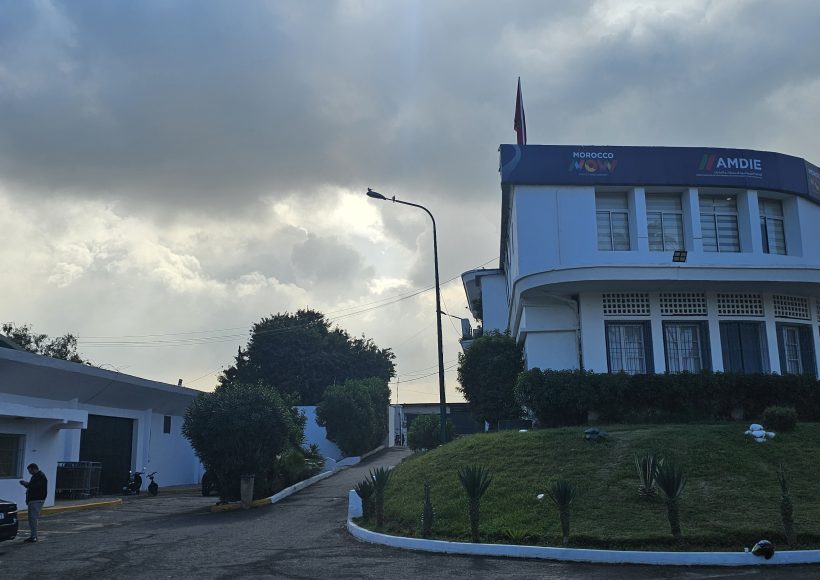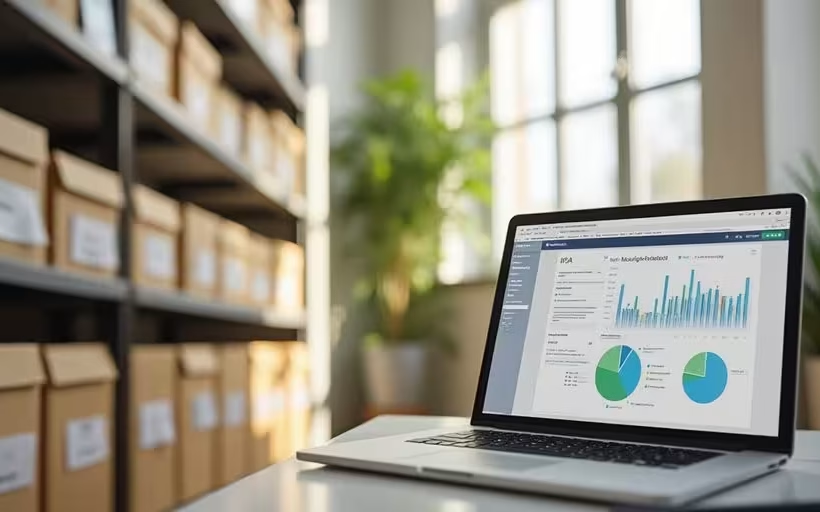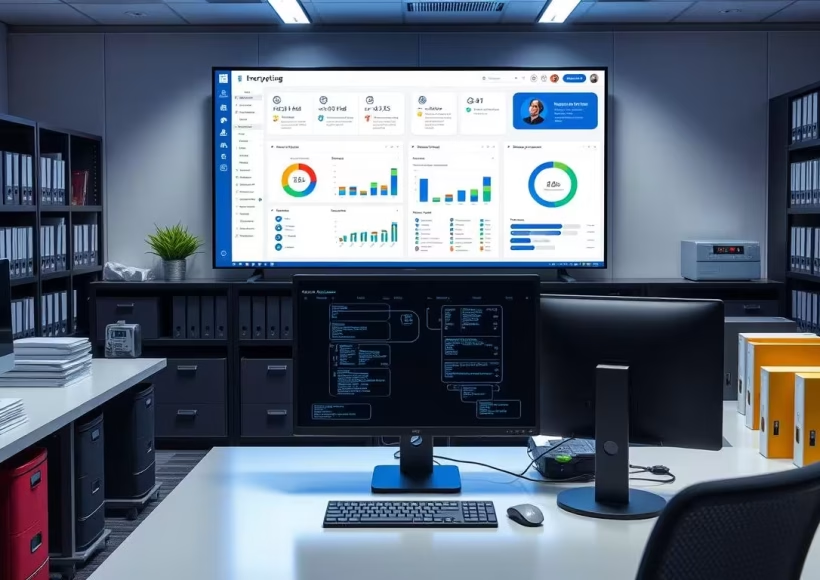- Mon - Sat 8:00 - 17:30, Sunday - CLOSED

ALKHADIM C2M: The Moroccan software that is revolutionizing business management on an international scale
Made in Morocco Software: A Digital Revolution in Progress ALKHADIM C2M: The All-in-One Management Solution for Moroccan Businesses In the era of digital transformation, Moroccan businesses need powerful tools tailored to their needs. ALKHADIM C2M, a 100% Moroccan software, provides a turnkey management system, covering the entire business cycle from purchasing or production to sales and accounting. With its intuitive approach and advanced features, ALKHADIM C2M helps SMEs, industries, and merchants optimize their operations, improve productivity, and simplify decision-making. A Complete Solution for Efficient Business Management 🔹 1. Purchasing & Inventory Management ✅ Real-time tracking of supplier orders and supplies ✅ Inventory management and restocking levels ✅ Automated low-stock alerts 🔹 2. Production & Traceability Management ✅ Planning of production processes ✅ Quality control and batch tracking ✅ Cost and deadline optimization 🔹 3. Sales & Invoicing Management ✅ Management of quotes, purchase orders, and invoices ✅ Client payment tracking and automated reminders ✅ Integration with accounting software 🔹 4. Reporting & Smart Dashboard ✅ Real-time performance analysis ✅ Key indicators to optimize profitability ✅ Secure data access via an intuitive interface Why Choose ALKHADIM C2M? 🚀 A 100% Moroccan software designed to meet local market needs ⚡ Time and efficiency gains with a simple and ergonomic interface 📊 Easier decision-making with quick access to strategic data 🔄 Seamless integration, compatible with accounting and management systems ALKHADIM C2M: The Ideal Solution to Digitize Your Business in Morocco Whether you are an SME, a large company, or a merchant, ALKHADIM C2M offers you a powerful management software that is secure and scalable. 🔍 Want to learn more? Contact us today and discover how ALKHADIM C2M can revolutionize your business management!

Optimize the management of your archives with combined solutions
Archive management is a crucial aspect for modern businesses, especially with the constant increase in data to process. Combined solutions effectively address the challenges related to archive management, ensuring security, compliance, and accessibility. This article explores how to optimize this management through innovative technologies and tailored solutions. Key Points Data is rapidly increasing, making flexible archiving solutions necessary. It is essential to comply with data protection laws to avoid penalties. The security of archived data must be strengthened against potential threats. Cloud solutions help reduce storage costs and improve data access. Integrating document management and archiving systems optimizes information management. Understanding the Stakes of Combined Archive Management Growing Data Volume Archive management has become a major challenge for businesses. Data volumes continue to increase rapidly, necessitating archiving solutions that can adapt. Companies must be prepared to manage ever-growing amounts of data without burdening IT teams. Legal and Regulatory Compliance Rules and laws regarding data management are constantly evolving. Companies must ensure that their archiving methods comply with these standards. This involves implementing strategies that facilitate compliance while meeting legal requirements. Data Security and Accessibility The security of archived data is crucial. They must be protected against loss and theft. At the same time, it is important that this data is easily accessible to authorized users. Archiving solutions must therefore balance security and accessibility. Combined archive management is essential to ensure that data is both secure and accessible while complying with legal standards. Main challenges: Increasing data volumes Evolving regulations Need for security and accessibility Challenges Description Data volume Exponential growth of data Compliance Adherence to laws and regulations Security Protection against loss and theft In summary, companies must navigate a complex landscape where combined archive management is essential for their future success. Innovative Technologies for Optimized Archive Management Archive management is rapidly evolving thanks to innovative technologies that facilitate data processing. These solutions address several major challenges faced by businesses today. Reducing Storage Costs Companies are constantly looking to reduce their costs related to data storage. Here are some effective strategies: Intelligent archiving of inactive data to less expensive storage solutions. Elimination of duplicates to free up space. Use of cloud solutions for flexible and economical access. Retention and Archiving in the Cloud Cloud archiving offers several advantages: Accessibility of data from anywhere. Enhanced security against loss and theft. Scalability to adapt to data growth. Self-Service Tools for Users Self-service tools allow users to manage their data without relying on IT teams. This includes: Simplified search for archived documents. Quick retrieval of necessary information. Permission management for secure access. By integrating these technologies, companies can not only improve their efficiency but also ensure the security and accessibility of their archived data. These innovations are essential to address the exponential growth of data and the increasing compliance requirements. Dell EMC Data Archiving Solutions Dell EMC is recognized as a global leader in data archiving. With its solutions, companies can effectively manage their data while meeting compliance requirements. Here are some key points regarding Dell EMC’s archiving solutions: Centralization and Analysis of Archiving Activities Centralization of data for simplified management. Analysis tools to track archiving activities. Detailed reports for better visibility. Interoperability and Application Support Support for a wide range of applications. Ensured interoperability to avoid compatibility issues. Solutions tailored to various environments, including the cloud. Simplification of Retention Policies Easy implementation of retention policies. Reduction of backup times for quick archiving. Optimization of performance for email systems and other data sources. Dell EMC’s archiving solutions enable companies to reduce storage costs while improving operational efficiency. Whether it’s servers, storage arrays, backup solutions, or data management software, you will find what you need at Dell to optimize your archive management. Benefits of Combined Solutions for Businesses Combined solutions offer numerous benefits for businesses, improving their efficiency and reducing costs. Here are some key points: Risk Reduction and Performance Improvement Data security: By integrating systems, companies can better protect their sensitive information. Process optimization: Combined solutions allow for task automation, reducing human errors. Improved responsiveness: Companies can respond more quickly to customer requests through better data management. Effective Management of Email Systems Centralization of information: Consolidating data helps better manage emails and avoid information loss. Reduction of mailbox size: This improves server performance and facilitates access to information. Self-service tools: Users can manage their own requests without relying on the IT team, speeding up the process. Optimization of Operational Performance Cost reduction: By using combined solutions, companies can decrease their expenses related to data storage and management. Improved efficiency: Processes are simplified, allowing employees to focus on higher-value tasks. Increased flexibility: Companies can quickly adapt to market changes through integrated systems. In summary, integrating IT solutions allows companies to better manage their archives, optimize their performance, and reduce the risks associated with data management. Integration of DAM and ECM Solutions for Effective Management Differences Between DAM and ECM Electronic Document Management (ECM) and Digital Asset Management (DAM) solutions share similar functions, but they address different needs. Here are some key distinctions: ECM: Focuses on managing textual documents, such as contracts and reports. DAM: Manages multimedia files, such as images and videos, often used in marketing. Interoperability: Both systems can be integrated for smoother content management. Seamless Integration of Solutions For effective management, integrating ECM and DAM solutions is essential. This allows for: Centralizing data: Consolidating all types of content in one place. Improving access: Facilitating the search and access to documents and media. Optimizing workflows: Automating processes to save time. Modular Approach and Open Architectures Integration of solutions should be modular and based on open architectures. This means that: Companies can choose the tools that best meet their needs. Systems can evolve over time without requiring major changes. Better collaboration between teams is possible through user-friendly interfaces. In conclusion, integrating ECM and DAM represents a strategic opportunity for companies looking to optimize their content management. Simplifying Archive Management with the Cloud Data Hierarchy and Deduplication Using the cloud for archiving helps reduce the volume of stored data. With technologies like deduplication, only unique data is sent, which decreases clutter and storage costs. This means that companies can save money while keeping

Why develop a mobile application for your business in Morocco?
In an increasingly digital world, developing a mobile application for your business in Morocco may seem essential. This approach offers numerous benefits, ranging from improving customer relationships to better visibility for your brand. In this article, we will explore the reasons why investing in a mobile application is a wise decision for Moroccan businesses. Key Points Mobile applications strengthen customer relationships by facilitating communication. They increase your brand’s visibility among users. A mobile application helps retain customers through exclusive offers. Working with a specialized agency allows for professional and rapid development. The Moroccan market offers competitive development costs and local talent. Benefits of a Mobile Application for Moroccan Businesses Improvement of Customer Relationships Mobile applications allow Moroccan businesses to enhance their digital presence. Through direct communication, businesses can better understand their customers’ needs and offer personalized services. This creates a stronger bond and improves customer satisfaction. Increased Brand Visibility A mobile application ensures constant visibility of the brand on users’ smartphones. This facilitates access to products and services, allowing businesses to stand out in a competitive market. Being always within reach, customers are more likely to interact with the brand. Customer Loyalty Applications offer exclusive benefits, such as promotions and rewards, that encourage customers to return. By providing features such as loyalty programs, businesses can increase customer engagement and encourage repeat purchases. In summary, having a mobile application has become essential for Moroccan businesses looking to grow and adapt to new consumer expectations. Benefits Description Customer Relationship Direct and personalized communication Visibility Constant presence on smartphones Loyalty Promotions and rewards for loyal customers Why Choose a Specialized Agency in Morocco Technical and Professional Expertise Engaging a smartphone application development agency in Morocco ensures a high level of expertise. The professionals at these agencies possess varied skills, ranging from development to graphic design. This guarantees that your application will not only be functional but also appealing to users. Comprehensive and Strategic Approach A specialized agency adopts a comprehensive approach to the development of your application. This means that it takes into account your business objectives, analyzes the market, and studies your competitors. This strategy allows for the creation of an application that truly meets your customers’ needs. Time Savings and Cost Reduction Outsourcing the development of your mobile application can save you valuable time. By entrusting this project to experts, you can focus on your core business. Moreover, development costs in Morocco are often more competitive than in other countries, allowing you to save while benefiting from quality service. By choosing a specialized agency, you ensure that you have an application that meets market standards while respecting your budget. Summary of Benefits Expertise: Team of qualified professionals. Strategy: In-depth analysis of the market and needs. Economy: Reduced development costs. In conclusion, opting for a specialized agency in Morocco for the development of your mobile application is a wise choice that can propel your business towards success. Key Steps in Developing a Mobile Application The development of a mobile application is a process that takes place in several essential steps. Each step is crucial to ensure the success of the application. Here are the main steps to follow: Defining Objectives and Design Needs analysis: Before starting, it is important to understand what the application should do and how it should function. This includes defining features and user expectations. Specifications document: A document detailing all technical and functional specifications is created. This document is essential to ensure that all stakeholders are aligned on the project. Mockups: Creating mockups allows for visualizing the user interface before development. This helps refine the design and user experience. Development and Programming Agile approach: Using an agile method allows for working in iterations, making adjustments easier during development. Technologies: Choosing the right technologies (native or hybrid) based on the specific needs of the application is crucial. Collaboration: Working closely with developers to ensure that the final product meets expectations. Testing and Improvements Rigorous testing: Before launch, it is essential to test the application on different devices to detect and correct bugs. Optimization: Improving performance and compatibility with different operating system versions is a key step. Submission to stores: Once testing is validated, the application is submitted to download platforms like Google Play and Apple App Store. By following these steps, you ensure that your mobile application is well-designed, functional, and ready to meet your users’ needs. Impact of the Moroccan Market on Application Development Development Costs in Morocco The cost of developing a mobile application in Morocco is often lower than in Europe. This attracts many companies looking to optimize their expenses while benefiting from quality service. Here are some key points to consider: Costs can range from 40,000 MAD to over 1,000,000 MAD depending on the complexity of the application. Moroccan companies can save up to 30% compared to European rates. The local market offers a qualified workforce at competitive rates. Local Opportunities and Challenges The Moroccan market presents interesting opportunities for application development, but there are also challenges to overcome: Rapid growth: The mobile application sector is booming. Increased competition: More and more development agencies are emerging. Adaptation to local needs: Applications must meet the cultural and economic specificities of the country. Regional Particularities Regional particularities also influence application development in Morocco. Here are some elements to consider: Language and cultural differences can affect the user interface. Technological infrastructures vary from region to region, impacting connectivity and access to services. Local regulations may impose additional constraints on developers. In summary, the Moroccan market offers a dynamic environment for mobile application development, but it is essential to understand the associated costs and challenges to succeed in this sector. Current Trends in Mobile Application Development Adoption of UX/UI Design UX/UI design has become essential for attracting and retaining users. A well-designed interface enhances the user experience and increases satisfaction. Moroccan companies must focus on intuitive and aesthetic designs to stand out. Preference for Native or Hybrid Development Companies are increasingly choosing between native and hybrid development. Native development offers optimal performance, while hybrid development allows for cost reduction. Here is a comparative table: Type of

Mobile Application Development in Morocco: Complete Guide
Morocco is a very active market for mobile applications. With more than 36 million people and more than 70% of smartphone users, it offers great potential. This guide walks you through the trends, technologies and best practices for building an app in Morocco. Key takeaways: The current state of the mobile application market in Morocco The mobile applications market in Morocco is growing fast. This shows the growing interest in digital and the needs of businesses. With a connected youth, Morocco is a good place to create innovative applications in different fields. Mobile consumption trends in Morocco People in Morocco spend an average of 3 hours a day on their mobile devices. They use applications a lot. Social networks, messaging, streaming and mobility services are very popular. This shows that people in Morocco are looking for useful and interesting mobile solutions. The sectors with the greatest demand for applications Opportunities in the Moroccan market The mobile applications market in Morocco offers great opportunities. SMEs want to transform themselves digitally. There is a great need for custom apps and mobile solutions for traditional industries. Key Indicators Values Number of smartphone users 22 million Smartphone penetration rate 62% Average number of apps installed 35 Average time spent on apps 3 hours per day These figures show the great potential of the mobile application market in Morocco. They offer great opportunities for entrepreneurs and developers. They can take advantage of the digital transformation underway in Morocco. Technologies and platforms for mobile development Companies in Morocco have several options for developing mobile applications. They can choose between Moroccan iOS development and Moroccan Android development. There are also cross-platforms for a more global approach. Choosing the right technology for mobile application development in Morocco< /strong> is crucial. It requires expertise to get the most out of the different platforms. This helps meet the needs of Moroccan users. Process of creating a mobile application in Morocco Conception and design phase < !-- wp:paragraph --> The first step is to define what the application should do and how it should work. You also need to think about its user interface. This is crucial for the app to be useful and easy to use for people in Morocco. Development and testing Then, the developers working on the application. They are implementing everything that has been planned. Meanwhile, tests are being done to make sure everything is working properly. Deployment and maintenance < p>When the application is ready, it is put online. But the work does not stop there. Regular updates must be made to ensure that it remains compatible with new versions of operating systems. This also allows to correct errors and add new features. Creating a mobile application in Morocco requires a lot of time and resources. But it is essential for mobile development companies that want to stand out in a growing market. Costs and investments for a mobile application Morocco Creating a mobile application in Morocco requires investments. The application development costs change according to several elements. This includes the complexity of the app, the features you want, and whether to go with a custom app or a pre-existing mobile solution. Enterprise mobile solutions are often less expensive up front. But they offer fewer customization options. In contrast, a custom mobile app is more flexible. But its development cost is generally higher. Element Estimated Cost Conception and design 5,000 – 15,000 MAD Development and testing 25,000 – 100,000 MAD Deployment and maintenance 2,000 – 10,000 MAD/year It should be noted that these figures are estimates. They can vary depending on the project and the development team. A detailed feasibility study will give a better idea of the app development costs for your business. “The success of a mobile application is not only measured by its development cost, but also by its ability to meet the needs of your users and generate value for your business.” In summary, investing in a mobile application in Morocco requires careful consideration. You need to choose the business mobile solutions that match your goals and budget. Mobile Development Solutions for Moroccan Businesses Moroccan businesses are looking to grow through digital transformation. Mobile applications are essential in this process. They can be customized or ready-to-use. Custom Applications vs. Pre-Existing Solutions Custom applications adapt perfectly to the needs of the business. But they require more money and time. Pre-existing solutions are more affordable and quicker to implement. However, they may not fit the unique needs of the business. The choice depends on resources, timelines, and feature complexity. Integration with Enterprise Systems Regardless of the choice, integration with existing systems is crucial. An enterprise mobile solution must communicate well with databases and management tools. This improves decision-making, productivity, and user experience. Security and Compliance Security and compliance are essential in the digital transformation in Morocco. SME applications in Morocco must protect data and comply with laws. Support from cybersecurity experts is often necessary. “Mobility has become an essential lever for the digital transformation of Moroccan companies. Choosing the right mobile solutionsis a key success factor.” Choosing your mobile development provider When you think about developing a mobile app for your business in Morocco, choosing the right mobile development provider is crucial. This choice will greatly influence the success of your project. Here are some key points to consider when finding the ideal mobile development agency: Watch the team’s technical skills. Make sure they are well-versed in the latest technologies and frameworks. Look at their experience in developing apps for similar mobile development companies. Their track record shows their expertise. Check out their reputation in the local developers in morocco market. Are they valued by their customers? Check their understanding of your industry and your goals. A good knowledge of your sector is a plus. Assess their ability to communicate and collaborate effectively throughout the project. By taking the time to carefully examine these criteria, you will increase your chances of finding the perfect mobile development provider for your mobile application project in Morocco.

How to Use RFID in Morocco: Complete Guide
RFID technology is rapidly transforming the business landscape in Morocco. Moroccan companies are adopting this radio frequency identification solution to improve their operational efficiency. This technology is becoming a key element of digital transformation in several sectors, from agriculture to logistics. This comprehensive guide examines the practical applications of RFID in Morocco and its benefits for businesses. Readers will discover the steps to implement an RFID system, best practices for inventory management, and solutions tailored to Moroccan SMEs. The article also addresses the current challenges and future prospects of this technology in the Moroccan context. Understanding RFID Technology Radio Frequency Identification (RFID) represents a major advance in the field of automatic identification. This technology uses radio waves to store and retrieve data remotely, offering remarkable possibilities for managing and tracking objects. The RFID system is based on two essential components: tags (or labels) and readers. RFID tags, consisting of an electronic chip and an antenna, can store up to 64,000 bits of data, allowing precise and detailed identification of objects. There are three main types of RFID tags: RFID technology is distinguished by its ability to read hundreds of tags simultaneously per second, without requiring a direct line of sight between the reader and the tag. Data can not only be read but also modified or rewritten, providing exceptional flexibility in information management. A complete RFID system also integrates a middleware that processes the collected data and transmits it to the company’s information system. This architecture allows for automated and efficient data management, contributing to improved traceability and inventory management. RFID Applications in Morocco In Morocco, RFID technology is revolutionizing many sectors of activity, offering innovative solutions for operations management. In the supply chain field, this technology enables real-time visibility and efficiency, eliminating errors throughout production, warehousing and distribution operations. The main applications of RFID in Morocco include: In the industrial sector, RFID allows companies to track their products at every stage of production and marketing. RFID tags offer significantly greater storage capacity than traditional barcodes, allowing to process up to 100 tags per second. The technology is also transforming retail. Moroccan retailers are using RFID to automate their inventories and reduce stockouts. RFID gates installed at the entrance and exit of stores provide effective protection against theft. This solution not only optimizes inventory management but also significantly improves the customer purchasing experience. In logistics, Moroccan companies are seeing a significant improvement in their operational efficiency. The technology makes it possible to synchronize physical flows with information flows, providing complete traceability and better anticipation of supply chain malfunctions. Implementation of an RFID system Implementing an RFID system requires a methodical and well-planned approach to ensure its success. Companies should follow a structured process that begins with a thorough pre-study phase to choose the RFID technology that best suits their specific needs. Essential implementation steps include: To ensure successful integration, several critical factors must be considered: End-user involvement is crucial, because the best technological system only works if users comply with its operating mode. Success is based on the combination of three fundamental parameters: the choice of the appropriate RFID standard, the establishment of a precise operating mode, and effective change management. The reliability rate of the system can be optimized thanks to a well-defined and integrated operating mode. Companies must also plan the modification of the activity’s IT management system and promote the rapprochement of several actors around the RFID project. Challenges and future prospects of RFID in Morocco Despite its transformative potential, the deployment of RFID in Morocco faces several significant challenges. The implementation cost remains a major obstacle, with RFID tags costing between ten cents and one euro, five to ten times more expensive than traditional barcodes. Key technical challenges include: Nevertheless, the future prospects are promising. The market for IT equipment for logistics in Morocco is experiencing an impressive growth of 30% to 40% per year. The country’s strategic geographical position, including its proximity to the Eurozone, offers significant opportunities for the expansion of RFID technology. Environmental ambitions are also supporting RFID adoption, with national targets to reduce CO2 emissions by 35%. This technology is perfectly aligned with the national strategy for the development of logistics competitiveness, which emphasizes modernization and operational efficiency. The Tanger-Med port plays a crucial role in this transformation, serving as a strategic hub for the flow of goods to Europe, America, West Africa and Asia. This infrastructure, combined with the flexibility of the Moroccan workforce, positions Morocco as a key player in the adoption of RFID technologies on a regional scale. Conclusion RFID technology marks a decisive step in the modernization of Moroccan companies. Radio frequency identification solutions demonstrate their added value across various sectors, from inventory management to product security. The positive results observed in companies that have adopted this technology confirm its essential role in improving productivity and reducing operational costs. Morocco is positioning itself as a major player in the adoption of RFID technologies in Africa, driven by its strategic geographical location and modern infrastructure. Despite the initial implementation challenges, future prospects remain promising, supported by the continued growth of the logistics market and government initiatives in favor of digital transformation. Moroccan companies that are investing in RFID today are giving themselves the means to effectively meet the growing demands for traceability and operational efficiency. FAQs Q: How can I use an RFID card?A: To use an RFID card, simply pass it in front of an RFID reader. This contactless system allows, for example, to recharge an electric vehicle while securing access and payment. Q: What are the steps to activate RFID on a device?A: To activate RFID, you must first activate the network on a smartphone via the Settings/Networks menus. Then, install an application like NFC Tools on Android, bring the smartphone within 10 cm of the RFID tag and program the desired action. Q: How does RFID access work?A: The RFIDpassive, which does not have a battery, works in read-only mode. The reader sends an electromagnetic signal to

Physical and Digital Archive Management: A Complete Guide for Businesses
Introduction Archive management represents a fundamental pillar in the organizational strategy of modern companies. In the digital age, the coexistence of physical and electronic documents requires a structured and methodical approach to ensure effective document management. This comprehensive guide is for companies that want to: The management of physical and digital archives encompasses several crucial aspects: Our guide will help you implement an archiving strategy that is adapted to contemporary challenges. You will discover the best practices for effectively managing your archives, whether on paper or in digital format. This integrated approach optimizes resources while ensuring the preservation of your information capital. 1. Understanding the importance of archiving for businesses Archiving represents a fundamental pillar in the organizational structure of modern businesses. This practice goes beyond the simple conservation of documents to become a real strategic tool. Legal compliance: an essential obligation Security of sensitive data Protecting confidential information requires a structured approach: Daily operational efficiency Optimized document management directly impacts the company’s performance: Companies that invest in suitable archiving solutions see a significant improvement in their performance. A well-designed archiving system helps reduce legal risks, protect information assets and optimise internal processes. 2. Types of archives in companies and their specific management Effective archive management is based on a thorough understanding of the different categories of documents and their life cycle within the company. Archives fall into three distinct categories, each requiring a tailored management approach. Current Archives: Active Document Management for Quick Access Current archives represent documents used daily in the operations of the business. These documents require immediate accessibility and rigorous organization. Main characteristics of current archives: Recommended management methods: Practical organization: Managing current archives requires a balance between accessibility and security. Documents must be easily accessible to authorized employees while remaining protected from unauthorized access. Tools and solutions: Intermediate archives: optimizing storage space with less frequently used documents Intermediate archives represent a specific category of documents whose consultation is becoming less regular. This intermediate phase requires an adapted storage strategy to optimize space while maintaining document accessibility. Characteristics of intermediate archives: Optimized storage solutions: Efficient management of intermediate archives is based on a three-pronged strategy: Thematic classification: The The establishment of a unified classification plan makes it possible to establish a standardized nomenclature. This standardization facilitates: Digital Security Sensitive Data Encryption< /li> Two-Factor Authentication Regular backups on redundant servers Document access logging< /li> Internal security protocols Assigning authorization levels to employees Traceability of consultations and modifications Mandatory “clean desk” policy Procedures for secure document destruction The ISO 15489 standard establishes precise guidelines for the implementation of a reliable document system. Companies must adapt these recommendations to their specific needs while respecting the regulatory framework. An effective storage strategy is based on: Regular risk assessment Updating security systems Continuing staff training in best practices The periodic audit of protection procedures The implementation of a hybrid storage solution makes it possible to combine the advantages of physical and digital archiving. This approach ensures optimal protection of sensitive data while facilitating their accessibility to authorized users. It is also crucial to integrate an effective fight against cybercrime into these strategies, because physical and digital security is not always enough in the face of growing threats in the virtual world. 4. Digitization and hybridization in modern archive management: towards a successful paperless transition! The digital transformation of archives represents a major development for modern businesses. This change requires a strategic and methodical approach to ensure an effective transition. Key steps in digitization: Audit of existing documents Selection of priority documents Definition of digitization formats Implementation of a system of backup Creating validation protocols Hybrid solutions: a smart compromise Adopting a hybrid system allows for a gradual and secure transition. This approach combines: The preservation of essential original documents The digitization of frequently consulted documents The electronic archiving of new documents The essential tools for hybrid management The success of this transformation depends on the use of suitable tools: High-definition professional scanners Optical recognition software (OCR) Electronic document management systems (EDM) Secure cloud storage solutions Good digitization practices The quality of the digitization directly impacts the efficiency of the system: Respect image quality standards Systematically index documents Check the integrity of the digitized files Put in place quality control procedures Ensure the traceability of operations This digital transformation requires a significant initial investment, but generates substantial savings in the long term by reducing physical storage costs and optimizing accessibilitydocument management. 5. Strategic benefits of good long-term document management for contemporary businesses Effective document management is a real performance lever for modern businesses. Tangible benefits are evident in several key aspects: Financial optimization Reduced physical storage costs Reduced costs related to the maintenance of paper archives Savings on supplies and archiving equipment Lower labor costs dedicated to document management Operational performance Acceleration of document research processes Reduced processing time for customer requests Improved collaboration between departments Increased productivity thanks to instant access to information Customer satisfaction reinforced Faster responses to documentation requests Personalized customer service thanks to accessible history Optimal traceability of exchanges and transactions Efficient dispute resolution thanks to documentary evidence Competitive advantage Accelerated decision-making thanks to organized data Improved analysis capacity for historical trends Increased responsiveness to market opportunities Enhanced protection of the company’s information assets The valorization of archived data allows companies to fully exploit their information capital, thus creating a virtuous circle of continuous improvement of performance. 6. Staff awareness and ongoing training as a key lever for effective archiving Training staff in best archiving practices is a strategic investment for your business. An effective training program is structured around several axes: Introduction sessions for new employees Introduction to archiving tools Specific filing procedures File naming rules Regular practical workshops Sorting exercises Documentary research simulations Real-life case studies To actively involve your employees, adopt these strategies: Designate “archiving ambassadors” in each department Create accessible visual guides on the intranet Organize monthly document organization challenges Set up a system for recognizing good practices Internal communication plays a central

Top most used software in Morocco in 2024
Companies in Morocco have many software options to choose from. They range from office software to cybersecurity. This article will explore the most important trends for 2024. Key takeaways: Current state of the software market in Morocco The digital sector in Morocco is growing rapidly. Software usage statistics show a strong dynamic. Digital transformation in Morocco is changing companies, pushing them to innovate. Evolution of the Moroccan digital sector Investments in digital infrastructure have modernized companies. Innovation in software in Morocco has accelerated this transformation. Companies now use advanced software tools to improve their productivity. Impact of digital transformation Digital transformation in Morocco has brought many benefits. Companies are becoming more efficient, reducing costs, and improving customer experience. This transition has also created new business opportunities. Trends in digital solution adoption These trends show the enthusiasm of Moroccan companies for software usage statistics. They want to fully embrace digital transformation in Morocco. “Digital transformation is no longer an option, but a necessity for Moroccan companies that want to remain competitive and adapt to market changes.” Dominant office software solutions in Moroccan companies In the professional world of Morocco, office software is very important. It helps make workers more productive. These productivity tools are essential to improve work methods. The Microsoft Office and Google Workspace suites are widely used. They offer many features. These include tools for writing, calculating, and presenting. The use of these popular office software has helped Moroccan companies become more productive. They simplify the creation, management, and sharing of documents. This helps teams collaborate more effectively. “Office software has become a cornerstone of our digital transformation strategy. It allows us to be more agile and respond more quickly to our clients’ needs.” – CEO of a Moroccan company In conclusion, popular office software is crucial for improving work processes. Its adoption by many companies shows its importance in the professional sector of Morocco. Business management software most popular Business management software is very important in Morocco. These are called ERP systems. They help companies manage their work better, from accounting to employee management. Leading ERP solutions Names like SAP, Oracle, and Microsoft Dynamics are very well-known in Morocco. They offer features for businesses of all sizes. These software improve data management and help make better decisions. Preferred accounting software Human resource management tools For human resources management, solutions like Cegid, ADP, and Talend are used. They simplify the management of payroll, leave, and training. “Business management software has become essential for Moroccan companies seeking to improve efficiency and competitiveness.” Growing e-commerce platforms Morocco is seeing an increase in the use of online commerce solutions. This reflects the ongoing digital transformation. Large e-commerce platforms offer Moroccan businesses new opportunities to sell online. The most used commercial management software include: These e-commerce platforms provide a major boost to Moroccan entrepreneurs. The e-commerce market continues to grow rapidly, providing opportunities for small businesses to reach a wider audience. “E-commerce has transformed how we do business. We can now reach customers from anywhere in the world.” Project Management Platforms These software for SMEs help to plan, track, and collaborate on projects. They enable teams to work together efficiently. In conclusion, communication and collaboration software is essential for businesses in Morocco. They facilitate communication, improve productivity, and encourage teamwork, whether remote or in person. Software Morocco : Cloud Solutions and Hosting Morocco is advancing rapidly in the use of cloud computing and software hosting. In 2024, cloud solutions are becoming increasingly popular among Moroccan businesses. They offer advantages such as reduced costs, flexibility, and easy scalability. However, challenges like data security and regulatory compliance remain. Giants like Microsoft Azure, Amazon Web Services (AWS), and Google Cloud Platform are at the heart of cloud software Morocco. They offer a variety of cloud services, from storage to business applications and virtual infrastructure. Moroccan companies are looking for secure and compliant cloud solutions. Cloud service providers are working to meet these specific needs of the Moroccan market. The digital transformation 2024 in Morocco is accelerating. Cloud solutions and software hosting are expected to become even more popular. They will help businesses improve their competitiveness and agility. Essential Business Mobile Apps The world is changing fast, and mobility is crucial. Business mobile apps are essential for companies in Morocco. They help stay efficient and connected, no matter where employees are working. Productivity Apps Productivity apps are indispensable for managing tasks and projects. Tools like Microsoft 365, Google Workspace, and Trello help professionals in Morocco. They can access their documents and communicate in real-time, even remotely. Mobile Payment Solutions Innovative software in Morocco has created mobile payment solutions. Apps like Paypal, Skrill, and Payoneer make transactions secure. This improves customer experience and financial management. Business mobile apps are essential for boosting productivity and simplifying payments. They make businesses more agile and efficient. They adapt to new trends in modern work. Cybersecurity Tools and Data Protection The digital transformation in Morocco raises significant challenges for cybersecurity. Companies must protect their data in the face of the expansion of sector-specific software. IT security is crucial for data confidentiality and integrity. Key cybersecurity tools for Moroccan businesses include: Employee awareness and training are also crucial. They help strengthen the protection of sector-specific software within the company. Cybersecurity Solution Key Features Benefits for the Business Firewall – Network traffic filtering– Detection of suspicious activities – Protection against unauthorized access– Prevention of network attacks Antivirus and Antimalware – Detection and removal of logical threats– Behavioral analysis of programs – Preservation of system integrity– Reduction of compromise risks Data Encryption – Encryption of sensitive information– Data access control – Preservation of data confidentiality– Enhanced regulatory compliance These tools are essential for protecting sector-specific software and critical data. They greatly contribute to the success of digital transformation in Morocco. Specialized Sectoral Solutions The digital market is growing rapidly, and Moroccan companies are looking for tailored software. These sector-specific software help improve productivity and competitiveness. Let’s explore some examples in key sectors. Banking Sector

RFID Technology in Morocco: Applications and Innovations
RFID Technology (Radio Frequency Identification) is gaining popularity in Morocco. It is a game-changer in industry and commerce, offering innovative solutions that make operations more efficient. It also helps with better stock management and tracking assets and the supply chain. Moroccan businesses are using these advancements to modernize and become more competitive. RFID technology is used in logistics and inventory management, and it also enhances the customer experience in stores. It is transforming the way products are tracked and controlled. The integration of RFID with the Internet of Things (IoT) and cloud solutions is opening new doors. This allows Moroccan companies to engage in innovation and digital transformation. Key Takeaways Current State of RFID Technology in Morocco Morocco is becoming a leader in the use of RFID technology. This revolutionary technology enhances efficiency and customer experience across multiple sectors. The implementation of RFID is becoming increasingly common. Adoption Across Different Sectors RFID technology is becoming more popular in Morocco. It is used in: Existing Technological Infrastructure Morocco has a developing RFID infrastructure, which includes: Key Market Players The Moroccan RFID market is driven by several key players, including: Companies Areas of Expertise Company X Design of RFID systems for logistics and traceability Company Y Integration of RFID solutions into enterprise information systems Company Z Manufacturing and distribution of RFID tags and readers tailored to local needs These smart technology solutions in Morocco based on RFID technology open new perspectives. They are gradually transforming practices in many sectors. Industrial and Logistics Applications RFID technology is very useful in industry and logistics in Morocco. It helps better manage inventory, track products, and improve production. RFID in Logistics and Supply Chain RFID in logistics and supply chain makes goods more visible. Companies in Morocco can better control their inventories. This reduces errors and improves stock management. RFID in the Manufacturing Sector In the manufacturing sector, RFID is essential. It automates production and tracks assets in real time. This optimizes processes, reduces downtime, and improves quality. Advantages of RFID in Industry Application Examples Product traceabilityOptimized inventory managementProcess automationError reductionQuality improvement Tracking shipments and deliveriesAsset and equipment managementProduct quality controlProduction line optimizationSecuring storage areas Companies in Morocco are increasingly using RFID. They aim to be more efficient, productive, and competitive in the market. “RFID has transformed our supply chain, allowing us to accurately track our products and respond quickly to customer demands.” – CEO, Automotive Manufacturing Company RFID in Moroccan Retail RFID technology is crucial for the digital transformation of retail in Morocco. It helps manage inventory, improve customer experience, and prevent losses. Moroccan retailers are increasingly adopting it. Inventory Management Solutions RFID tags and readers allow merchants to track their inventory in real time. This optimizes shelf management. Increased visibility reduces stockouts and improves item turnover. Enhanced Customer Experience Using RFID technology makes shopping smoother. Customers benefit from a personalized experience. Features like automatic item detection at checkout make purchasing easier. Loss Prevention RFID allows precise tracking of inventory and movements. This helps prevent theft and restocking errors. The technology optimizes margins and improves profitability. RFID solutions offer many advantages to retailers in Morocco. They transform the shopping experience and improve inventory management and profitability. Digital Transformation of Moroccan Businesses Digital transformation in Morocco is advancing rapidly. Companies are adopting RFID technology to boost their digitalization. This technology enhances efficiency, decision-making, and innovation. RFID helps Moroccan companies automate their operations. This reduces errors and optimizes stock management. Leaders can make informed decisions thanks to real-time data. RFID also paves the way for innovation. It enables the development of traceability solutions and improves customer experience. It’s a major asset for the digital transformation of Moroccan companies. “RFID is a key element of digital transformation, enabling companies to increase their efficiency and competitiveness.” Morocco is engaging in its digital transformation. RFID technology is essential for the digital transformation of businesses. It offers numerous strategic and operational advantages. Traceability and Real-Time Tracking Solutions RFID tracking solutions are changing asset management for Moroccan companies. They enable real-time tracking of key elements, improving quality control and helping to make better decisions. Asset Tracking Systems RFID asset tracking systems help locate and monitor equipment and resources. This reduces losses and improves asset utilization. Supply Chain Management Using RFID technology in the supply chain ensures perfect traceability. It enhances forecasting, inventory management, and logistics flow coordination. Quality Control RFID tracking solutions allow for real-time monitoring of product quality. This helps identify and quickly address issues, ensuring product quality. “RFID technology has revolutionized how we manage our assets and supply chain. We’ve significantly improved our operational efficiency and customer satisfaction.” – Operations Manager, Moroccan Logistics Company Security and Authentication with RFID RFID technology is crucial for security and authentication in Morocco. It helps combat counterfeiting and secures access to locations. Additionally, it protects official documents. Counterfeit Protection RFID enables automated tracking of products, preventing the circulation of counterfeit goods. This technology is widely used in luxury and electronics sectors to protect brands. Secure Access Control RFID authentication systems are common for access control. They are used in businesses and government buildings. RFID badges quickly identify authorized individuals and block unauthorized access. Securing Official Documents RFID also secures identity documents and passports. RFID chips instantly verify the authenticity of these documents, reducing the risk of forgery. RFID technology enhances security and authentication across various fields in Morocco. It is seen as a promising emerging technology. Recent Innovations and Developments The Moroccan RFID technology market is booming, with numerous innovations transforming industries. These advancements are paving the way for exciting new applications. Moroccan companies are exploring the latest advancements, aiming to improve efficiency, traceability, and customer experience through integration with the Internet of Things (IoT) and cloud computing. New Applications RFID is increasingly used in sectors like healthcare, agriculture, and transportation. For example, RFID bracelets monitor patients’ health in real time, while RFID sensors enhance crop production and traceability in agriculture. IoT Integration Cloud Solutions Moroccan companies are adopting cloud-based RFID solutions, benefiting

Archive Management Software: Essential Features to Look For
The digital world has transformed the role of order offices. Digital order office software helps companies manage their administrative tasks better. They improve document management, make correspondence tracking easier, and automate repetitive tasks. This increases productivity and enhances organization. Whether your company is small or large, these software solutions bring benefits. They allow work without the need for a physical office, reduce paper management costs, and improve team work experience. Key Takeaways: Understanding Digital Order Office: Definition and Key Principles The digital order office is a major advancement in corporate document management. It transforms traditional methods, making them more efficient and secure. This makes documents more accessible. The Evolution from Traditional to Digital Order Office The order office was once based on paper archives and manual processes. Now, digitization of administrative processes is changing everything. It enables digital document management, correspondence tracking, and secure archiving. Strategic Role in Digital Transformation The digital order office is crucial for the digital transformation of companies. It automates tasks, facilitates information access, and enhances traceability. This optimizes administrative processes. Impact on Administrative Organization The adoption of the digital order office greatly changes administrative organization. It reduces repetitive tasks and improves collaboration, allowing focus on more important activities. “The digitization of the order office is a powerful lever to improve operational efficiency and corporate productivity.” Key Advantages of Order Office Digitization Order office digitization brings numerous advantages. It helps companies improve their administrative efficiency and leverage digital technologies. Let’s look at the main benefits of this transformation. Digitalizing the order office enables efficient and organized document management. Companies can securely archive, search, and share their documents. This reduces the risk of information loss and enhances traceability. In summary, digitalizing the order office is a strategic opportunity for companies. It optimizes administrative processes and improves operational efficiency, making it an essential step in an organization’s digital transformation. “Digitalizing the order office reinvents administrative processes, providing employees with a smoother and more productive work experience.” Essential Features of Digital Order Office Software Digital order office software brings substantial benefits to companies. They offer key tools for better management, including electronic incoming document management, correspondence tracking and traceability, and a digital archiving system. Electronic Incoming Document Management Electronic Document Management (EDM) is essential, allowing documents to be digitized. This simplifies information search and access. Correspondence Tracking and Traceability Order office software also aids in tracking correspondence, providing tools for task management and alert notifications, enhancing team coordination. Digital Archiving System Additionally, these solutions offer an effective digital archiving system to securely store documents, ensuring long-term conservation and traceability. In summary, digital order office software transforms companies by enhancing document management and administrative processes. Optimizing Administrative Processes with Digitalization The digital order office has revolutionized administrative processes, increasing efficiency and productivity. Task automation and electronic document management are pivotal in this transformation. Companies benefit from automating administrative documents, reducing errors, and accelerating tasks. Digitalization also enhances traceability, secure archiving, and cost reduction. Key Optimization Features These features help businesses better manage their digital document workflow. They improve processes, reduce manual tasks, and ensure proper document control. Administrative Processes Before Digitalization With Digital Document Workflow Incoming Document Management Manual, with risk of errors Automated, with traceability and secure archiving Correspondence Processing Slow and tedious Fast and intelligent, with workflow tracking Document Archiving Physical, with risk of loss Digital, secure, and easily accessible Optimizing digital document workflow and automating administrative documents are crucial. They streamline processes and boost operational efficiency. Security and Confidentiality of Digital Documents Protecting digital documents is essential in today’s world. Digital document workflow software offers advanced security measures, ensuring the security of digital documents and confidentiality of administrative data. Advanced Security Protocols These solutions use cutting-edge security protocols, including data encryption, two-factor authentication, and access logging. These measures protect the integrity and confidentiality of documents. Access Rights Management Digital document workflow software offers advanced access rights management. Administrators can set specific permissions, so only authorized personnel can access documents. Sensitive Data Protection These solutions allow the classification and labeling of sensitive documents. They offer tools to identify and protect these data, with backup and disaster recovery measures integrated. Using digital document workflow software, organizations improve security and confidentiality while optimizing administrative processes. Security Features Benefits Data Encryption Preserves document integrity and confidentiality Access Rights Management Limits access to authorized personnel only Document Classification Identifies and protects the most sensitive data Backup and Recovery Ensures information continuity and availability Integrating the Document Workflow Software into Existing Infrastructure Adopting a digitalized document management solution requires smooth integration into your IT system, a crucial step for a seamless transition. Here’s what you need to know to ensure a successful integration. Compatibility with Existing Systems Ensure your document workflow software works well with your current systems. It should align with other digitalized document management solutions such as messaging and document management. Interconnectivity and Interoperability Identify where your document workflow software needs to communicate with other systems. This should happen smoothly to enhance your administrative processes. Training and Support for Adoption Organize training for your team to ensure a smooth integration of the document workflow software. Help them learn and use the tool quickly. Key Considerations Best Practices System Compatibility Evaluate compatibility with existing infrastructure Interconnectivity Identify required points of connection between systems User Training Implement a comprehensive training program By following these tips, the document workflow software integration will go smoothly. Your organization will fully benefit from a digitalized document management solution. How to Choose the Best Solution for Your Organization Finding the right digital office software may seem difficult. However, by following certain criteria and comparing options, you will find the ideal solution. Here are key points to consider when choosing the best digital office software. Essential Evaluation Criteria Comparison of Available Solutions Features Solution A Solution B Solution C Management of incoming documents ✓ ✓ ✓ Tracking and tracing of correspondence ✓ ✓ ✓ Digital archiving ✓ ✓ ✓ Integration with other systems ✓ ✓ – Security level



